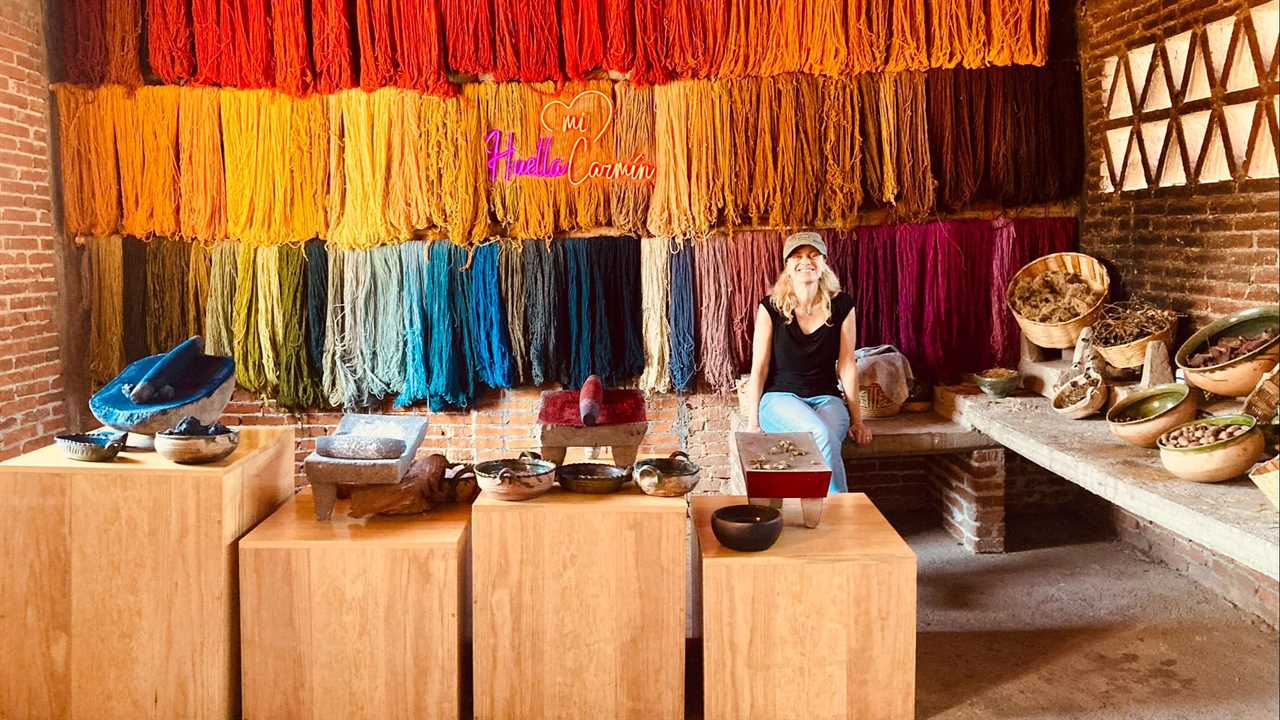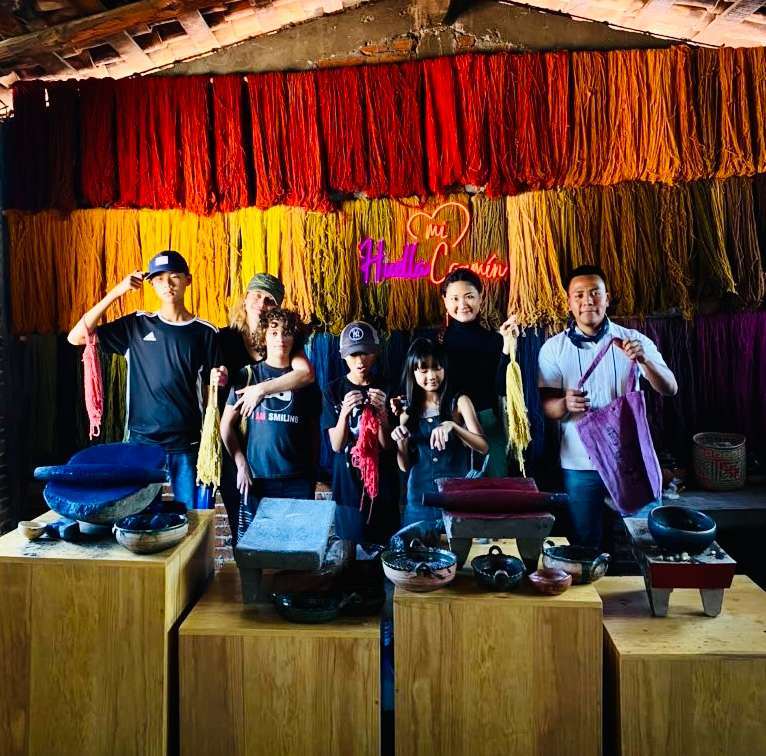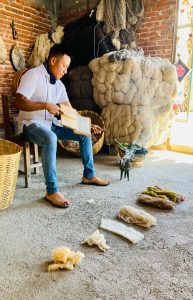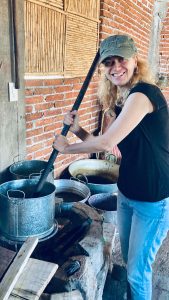LISTEN TO THE EPISODE:
APPLE PODCASTS | SPOTIFY | GOOGLE PODCASTS
Natural Dyeing and Weaving in Teotitlan del Valle, Mexico

Today we’re going to be talking about a natural dye and weaving workshop in Mexico. My friend in Oaxaca was traveling with her family and our family. My friend loves to do weaving. She’s really into textiles. She’s really into indigenous villages where they have all these different textiles and how they make them. Honestly, it’s not something that I’ve even thought about. It’s not something I really want to do. Unlike some of the other things I really love to do.
But when she mentioned that outside of Oaxaca, about 45 minutes away, there is a really well-known place that is popular for these textiles. You could do workshops learning how to do that. The area is Teotitlan del Valle. It is 45 minutes outside of Oaxaca.
It’s a distinct indigenous region, and they really still do all of their textiles. There was this tour that we could do or an experience that we could do. And I’m like, you know what, This is excellent. I really don’t know much about this. I would love to do that. And it’s funny because my twelve year old son, and she has three kids of her own, he’s like, why do we have to do these types of workshops? I’m like, Because if we don’t, we don’t know anything about these things. When we end up doing these types of workshops, these types of things, we learn more, and maybe we even fall in love with it and want to explore it more and maybe do more of it.
My son once again reminded me that he’s never done that. I reminded him, remember that one time when we did a day of wakeboarding? We knew nothing about wakeboarding ever, and they totally fell in love with it. And today my oldest son still does wakeboarding a little bit. So there you go. If you don’t expose your children to cool different experiences and yourself, you won’t really learn much. My friend signed us up.

Natural Dyeing and Weaving in Teotitlan del Valle, Mexico
It is in the actual value. You had to drive there in Teotitlán del Valle, and it was this one guy, it was a family-run business and he opened it up for workshops. That’s what they do. It’s a very professional, all-natural workshop.
It was a really cool experience because it’s something I would never do. We started off learning how to do everything there is with sheep wool. And so we started off learning how they even do the thread. How they do the loom.
Natural Dyes
The dyes are natural. Some of them are from flowers. One of the dyes was from this insect that lives which actually is like destroying the cactus they eat here. Nopal cactus is a very popular food in this region. And this particular insect destroys it. So the indigenous used to take the insect and somehow realize that it has a natural color to it. So now they use it as a dye, a bright red dye. It’s so cool. So we were able to do that. And you learn how to crush it. And just the whole process.
The whole class was a process of doing all these different steps until the actual dyeing. Like, we cooked the colors, we cooked the dyes, and we put in the thread. So they stayed there all on an open fire. He even did this because we are in the region of mescal. He did a mescal cleansing ceremony.
Then, while our dyes and our threads were absorbing the dyes, some of these dyes, and the colors take weeks. Obviously, ours was just a 30-minute wait time, but we really learned about the process.

Weaving Looms
While we were waiting for the color to be absorbed, we went downstairs. They have these huge weaving looms. So we were doing the actual weaving, what these villagers and indigenous people do.

Weaving Process
The Thread
The thread takes hours. Like, you have to go through the whole thing, through the wool. And that’s just the thread. It was so much work just for the thread.

The Dyes and Grinding
Then to grind the dyes first or gather the different plants, some of these plants and these insects, you have to dry for weeks on end.

Then you have to grind them. Then you have to mix in the proper color with different mixtures and limestones to give you the vibrant colors that you want. And they have hundreds of colors, right? We take this all for granted.

Then you have to cook it. You have to let the color absorb. Some of them, as I said, take two weeks or longer. Then, once that is absorbed, you have to have the thread. Each thread has to be separated. Then the designs and they’re all done on these looms.

How Much Time does it take?
Every little thing takes days to do. It is like the woman was telling us that it could take between five days to a month to do. We’re like, but what does that mean? Five days to a month? How many hours a day? And it’s 10 hours per day, one person only.
It’s not like they rotate, and they don’t take breaks like we are accustomed to. 10 hours every single day until that one thing, whatever it is, either a runner or a tapestry or their clothing takes to do it, is hours. So when you learn the process, and the manual labor behind it, you will never negotiate again. To be honest with you, hearing their prices, I really wonder if they undervalue entirely themselves in the first place. So the experience really woke us up.
Don’t Bargain
Let me tell you one thing I have to say, especially living in Guatemala, where you see these textiles everywhere in all these different markets, and Mexico is just as big on it as well. You see all these foreigners coming in, and even the locals who are bargaining these people and their handiworks. A lot of the majority of it is all handcrafted, done by hand. I think that everyone needs to take a class like this one to understand the laborious process that goes behind it.
Conclusion
Even though my son was like, I don’t like these types of workshops, he was really into a lot of the different steps. He loved the grinding, he loved to make the actual colors, and he did the weaving. It’s such a great thing to do with your kids. They get really involved and they learn the process. Even though they might never use this information again, they have it there.
And if by any chance they are in some area, they will have that respect a lot more than just seeing it in the market already being done. So if you could do something like that, I highly recommend in many places, especially throughout Central America, to have these weaving classes, these natural dye classes, workshops that are just really well-structured and super fun. Again, I personally really recommend it. And before we went to the actual dye, we went to check out the village as well as this cute little village to see how the locals really are and their market. It was just a really fun afternoon.
It was only half a day altogether, including the drive and the checking out of the marketplace and the village. So if you guys have a chance to do something like that, I really recommend it.
How to subscribe?
If you subscribe to my podcast you’ll be the first one to know when a new podcast is up!
- Subscribe on iTunes.
- Follow-on Spotify.
- Subscribe on Google
Did you enjoy the podcast? Leave a Review!
Leave a review on Apple Podcast! They are one of THE most important factors for podcasts, and it’s super easy to do:
- Click on “View in iTunes” on the left-hand side under the picture.
- Leave an honest review.
- Thanks, you’re super!
The post Natural Dyeing and Weaving in Teotitlan del Valle, Mexico appeared first on Travel Experta - Travel, Lifestyle, Freedom.
------------------------------------------
By: Angel
Title: Natural Dyeing and Weaving in Teotitlan del Valle, Mexico
Sourced From: travelexperta.com/natural-dyeing-and-weaving-in-teotitlan-del-valle-mexico/
Published Date: Thu, 11 May 2023 17:00:49 +0000
Did you miss our previous article...
https://consumernewsnetwork.com/travel-news/the-5-best-hostels-in-cebu-to-party-or-chill-in-2023-for-solo-travelers






